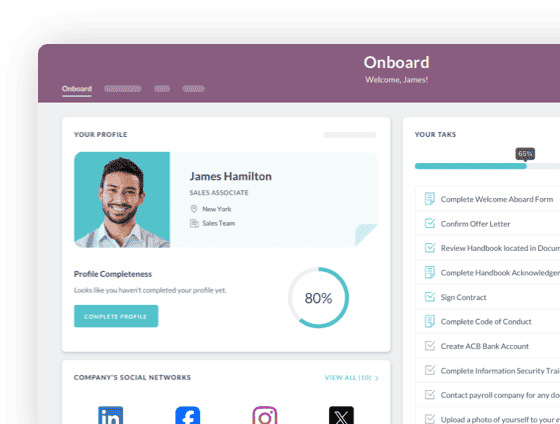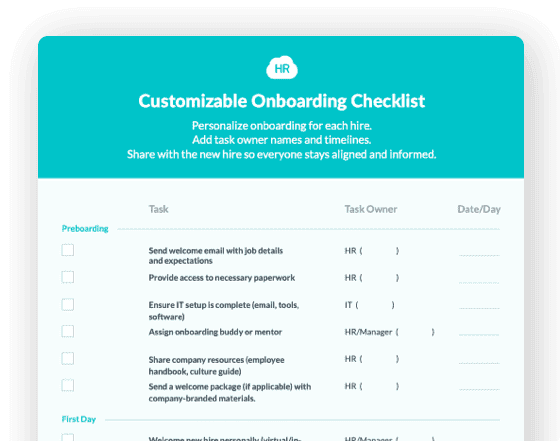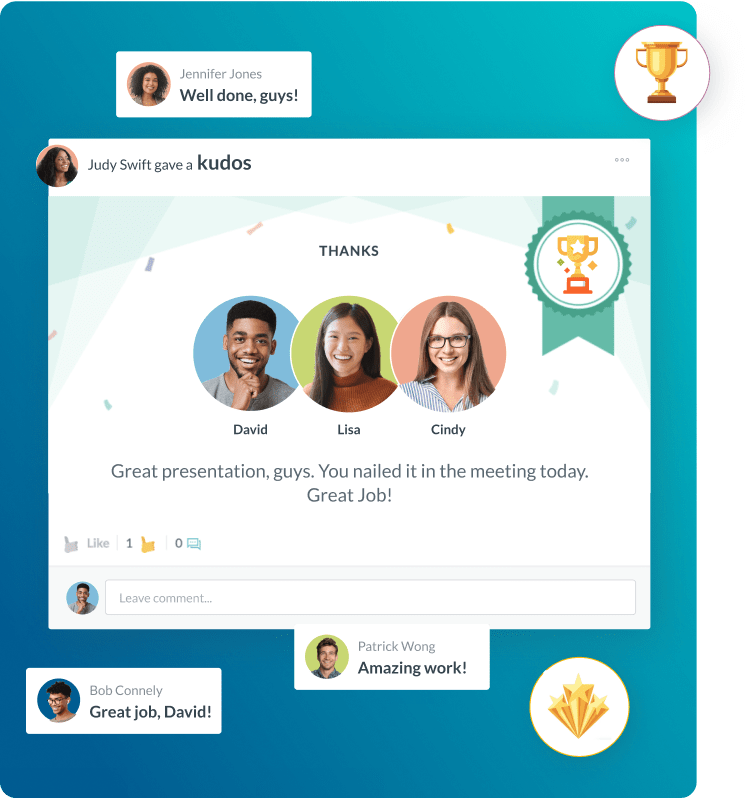Pre-Tax Deductions
- Key Points for Executive Review
- Common Pre-Tax Deductions Examples and Their Tax Impact
- Value-Adding Comparison: Pre-Tax vs. Post-Tax Deductions
- Best Practices for Managing Pre-Tax Deductions
- Pitfalls to Avoid in Pre-Tax Deduction Management
- Industry Applications of Strategic Pre-Tax Deductions
- Implementation Plan: A Step-by-Step Guide for Applying Pre-Tax Deduction Concepts
- Future Outlook and Trends in Pre-Tax Deductions

 Cut onboarding time
by 60%—here's the
Ultimate Checklist
that helped do it.
Cut onboarding time
by 60%—here's the
Ultimate Checklist
that helped do it.

Pre-tax deductions are amounts you take out of an employee’s gross pay before you calculate and hold back income taxes. For business leaders, you must understand these deductions. They directly affect payroll processing, tax rules, and how competitive your overall employee benefits package is. These deductions cut an employee's taxable income. This means the employee pays less in federal, state, and sometimes local income taxes.
When you offer a strong pre-tax deduction program, your company does more than just accounting. You use a smart financial strategy. Cutting an employee's taxable wage base leads to two main upsides. First, it puts more take-home pay in the employee's pocket. This makes your compensation package more appealing. Second, it lowers the company's cost for certain payroll taxes. These taxes are FICA (Federal Insurance Contributions Act) and FUTA (Federal Unemployment Tax Act). Leveraging pre-tax options is a key tool for keeping employees and saving money on company-wide taxes. This makes managing payroll deductions a strategic priority, not just a simple process.
Key Points for Executive Review
Putting pre-tax deductions in place is a main part of modern human resources management and financial planning. Here are the main ideas for your leaders:
Tax Efficiency for Employees:
Pre-tax deductions cut an employee's total taxable income. This results in immediate income tax savings.
Employer Cost Savings:
Companies save money on matching FICA contributions for every dollar an employee puts in pre-tax. These FICA taxes include Social Security and Medicare taxes.
Voluntary Enrollment:
These deductions are almost always voluntary. They need clear employee enrollment and usually fall under a Section 125 Cafeteria Plan to keep their tax-exempt status.
Compliance Complexity:
Different types of deductions are exempt from different taxes. For example, a standard 401(k) contribution is usually subject to FICA. However, most health insurance premiums are exempt from all three: federal income, state income, and FICA taxes.
Competitive Benefits:
Offering and clearly talking about these options, like a Flexible Spending Account, makes your total compensation package better. This greatly helps your efforts in talent acquisition and retention efforts.
Common Pre-Tax Deductions Examples and Their Tax Impact
The most common and helpful pre-tax deductions involve health and retirement savings. The Internal Revenue Service (IRS) sets specific rules for these tools. Employers must keep careful records and follow all rules. Their main goal is to encourage people to save for future healthcare and retirement needs. Having the right structure for these payroll items is part of good HR practices for legal compliance and happy employees.
The following are the most common and beneficial types of pre-tax deductions:
Health Insurance Premiums
This is the part of the cost for medical, dental, or vision insurance that the employee pays. When you deduct these pre-tax under a Section 125 Plan, the premiums are usually exempt from all federal, state, and FICA taxes. This deduction is often the largest one an employee takes pre-tax.
Traditional 401(k) and 403(b) Retirement Contributions
Money put into these qualified retirement plans is a main example of delayed income taxation. You deduct the money before federal and state income taxes apply. However, it remains subject to FICA taxes. The employee only pays income tax when they take the money out in retirement.
Health Savings Accounts (HSA)
An HSA must go with a High-Deductible Health Plan (HDHP). It offers triple tax advantages: Contributions are pre-tax, the money grows tax-free, and withdrawals for approved medical costs are also tax-free. Contributions are exempt from all federal, state, and FICA taxes. This feature also lowers the employer’s FICA tax liability.
Flexible Spending Accounts (FSA)
Employees can set aside pre-tax money for specific costs, such as healthcare or dependent care. These funds are exempt from federal, state, and FICA taxes. A key difference from an HSA is the "use-it-or-lose-it" rule. This rule means most funds must be spent within the plan year. The plan often allows some carryover or a grace period.
Commuter Benefits
These deductions cover approved travel costs, like mass transit passes or parking. They are pre-tax and lower federal and state income tax liability. But the funds still face FICA taxes. The law sets annual limits on how much an employee can set aside for these benefits.
Value-Adding Comparison: Pre-Tax vs. Post-Tax Deductions
Pre-tax deductions offer immediate tax relief. Still, they are not the only type of withholding. Post-tax deductions happen after all taxes are calculated. They serve other important purposes. Deciding which benefits to offer as pre-tax versus post-tax is a key job for HR and finance teams. The table below shows the core difference with common examples.
|
Feature |
Pre-Tax Deduction |
Post-Tax Deduction |
|
Timing of Deduction |
Before calculating income and sometimes FICA/FUTA taxes |
After calculating all mandatory taxes |
|
Impact on Taxable Income |
Reduces employee's taxable gross pay |
No impact on taxable gross pay |
|
Typical Examples |
Health Insurance Premiums, Traditional 401(k), HSA, FSA |
Roth 401(k) Contributions, Wage Garnishments, Union Dues, Charitable Donations |
|
Employer Tax Savings |
Yes, reduces employer-paid FICA/FUTA taxes |
No, the deduction is taken from net pay |
|
Employee Tax Benefit |
Immediate tax savings and increased take-home pay |
Tax-free growth and/or tax-free withdrawal (e.g., Roth) |
Best Practices for Managing Pre-Tax Deductions
It is critical for business leaders to use a process that is clear, steady, and compliant for pre-tax deductions. If you fail to follow federal rules, like those for a Section 125 Plan, it can cause high penalties. It can also make employee income taxable in the past. These tips will help you keep strong HR operations.
Formalize a Section 125 Cafeteria Plan Document
You must have a formal, written Section 125 Cafeteria Plan to offer most health and welfare benefits pre-tax. This document is a vital legal rule. It controls which benefits you offer and the terms for joining. You must manage this plan carefully by strict IRS rules.
Automate Payroll and Compliance
Do not use manual steps for complex payroll items. Invest in a reliable payroll system. This system should automatically use the correct pre-tax deduction rules. This ensures you calculate taxable wages correctly and follow federal and state withholding laws. This automation is key to effective HR Cloud operations and reduces human mistakes.
Conduct Regular Employee Education
Many employees do not fully understand the difference between pre-tax and post-tax contributions. This is especially true for Roth versus Traditional retirement plans or the "use-it-or-lose-it" rule of an FSA. Regular Employee Education with clear communication is key. It helps employees get the most from their benefits and avoid compliance problems.
Ensure Timely Remittance and Reporting
Employer duties go beyond just payroll. You must ensure you send all withheld funds quickly and correctly to the right administrators. These include 401(k) custodians or FSA processors. Timely reporting on Form W-2 and other tax forms is required for all pre-tax contributions.
 Discover how our HR solutions streamline onboarding, boost employee engagement, and simplify HR management
Discover how our HR solutions streamline onboarding, boost employee engagement, and simplify HR management
Pitfalls to Avoid in Pre-Tax Deduction Management
Even experienced finance and HR teams can get confused by pre-tax deduction details. Executives must stay alert to stop common errors. These errors can cause legal issues, unhappy employees, and financial losses.
Failing to Separate Retirement and Health Tax Status
A common mistake is treating all pre-tax deductions the same for FICA tax. Traditional 401(k) contributions are generally subject to FICA. Health premiums under a Section 125 Plan are generally exempt. Wrongly calculating this difference leads to incorrect FICA tax withholding and reporting.
Incorrectly Applying IRS Limits
All qualified pre-tax plans have strict yearly contribution limits set by the IRS. This includes the 401(k), HSA, and Dependent Care FSA. Exceeding these limits, even by accident, can cause tax penalties for both the employee and the employer. Your payroll system must track these amounts carefully all year long.
Non-Compliance with Section 125 Election Changes
A Section 125 Cafeteria Plan demands that employees make elections only once a year during open enrollment. This applies to health premiums or FSA amounts. Changes outside of this window are only allowed after a specific Qualifying Life Event, like marriage or the birth of a child. Allowing changes without authorization breaks the rule. It can disqualify the whole plan and make all employee pre-tax benefits taxable. You can read more about these rules on the IRS website.
Misclassifying Post-Tax Items as Pre-Tax
Items like union dues, some life insurance premiums (above the $50,000 threshold for group-term life), or pet insurance generally cannot be taken pre-tax. Processing these incorrectly as pre-tax deductions can lead to big payroll tax errors that cost a lot to fix.
Industry Applications of Strategic Pre-Tax Deductions
The way companies use pre-tax deductions changes by industry. This reflects their pay structures, workforce type, and goals. For employers, matching the benefits strategy to these industry needs gives a competitive edge. A benefits survey shows that the kind of benefits a company offers is a key factor in attracting specific talent.
Technology and Software
Tech companies often compete fiercely for talent. Their strategy focuses heavily on maximizing retirement savings. They often feature high company-matching contributions to a traditional 401(k) plan. They also offer strong HSA plans with generous starting funds. The focus is on long-term money security and high-value, tax-advantaged savings tools. This appeals to a well-paid, tax-aware workforce. Experts highlight the HSA's value as a long-term savings tool due to its tax benefits.
Retail and Hospitality
These industries often hire more part-time or hourly workers. The strategy here focuses on low costs and basic wellness. They use pre-tax deductions for low-cost, high-value plans. A key strategy is to push Flexible Spending Accounts for dependent care or basic medical costs. These are vital for working families. Clear talk about the cut in gross pay for insurance premiums makes necessary healthcare coverage more affordable.
Government and Public Service
Public sector groups rely heavily on rules and established structures. They often offer defined-benefit pension plans or 403(b) retirement accounts that use pre-tax contributions. They also use large pre-tax commuter benefits to push the use of public transit. This fits with city goals for sustainability. It also gives employees traveling to main government offices a valuable, tax-advantaged perk.
Implementation Plan: A Step-by-Step Guide for Applying Pre-Tax Deduction Concepts
Putting pre-tax deductions in place and managing them well needs a planned approach. It must involve HR, Finance, and IT working together. This step-by-step plan ensures a smooth start and lasting compliance. This process is key for simplifying your payroll deductions procedures.
Phase 1: Foundation and Planning
Select and Design Benefits: Decide which pre-tax benefits to offer, like a traditional 401(k), HSA, or FSA. Check the IRS contribution limits for the current tax year.
Establish Legal Plan Documents: Hire a benefits attorney or expert to write or update the official Section 125 Cafeteria Plan document. Do the same for all related retirement or health plan documents. This is a required legal step.
Procure Technology: Make sure your HR and payroll software can correctly calculate and hold back all required and voluntary pre-tax contributions. This ensures the correct taxes (federal income, state income, FICA) are exempt for each deduction type.
Phase 2: Enrollment and Communication
Educate the Workforce: Create clear materials—videos, guides, and live sessions—to explain the financial benefits of pre-tax options. Stress the long-term effect of choosing an HSA or an FSA. Also, emphasize the importance of annual election during open enrollment.
Conduct Open Enrollment: Use the official enrollment time to get employee benefit choices. Get their written permission for all voluntary pre-tax deductions. Document everything carefully as the IRS requires.
Phase 3: Ongoing Operations and Compliance
Execute Payroll Processing: Be sure the payroll department enters the pre-tax deduction amounts into the system accurately. You must take payroll deductions before you calculate the adjusted gross income.
Reconcile and Remit Funds: Set a strict schedule to check the amounts you withheld from paychecks against the amounts due to plan administrators. Ensure you send the funds on time. This prevents compliance issues for the plan.
Annual Review and Audit: At least once a year, look over your plan documents. Re-run non-discrimination tests required by Section 125. This ensures the plan does not favor highly compensated employees too much. Also, check that all employee and employer contribution limits are followed correctly.
Future Outlook and Trends in Pre-Tax Deductions
The world of pre-tax deductions keeps changing. It is driven by new laws, healthcare costs, and what today's workers want. Business leaders must watch new trends to keep their benefits competitive and correct.
One clear trend is the rising importance of the Health Savings Account. Financial experts like the HSA for its "triple tax advantage" and the ability to take it with you. This makes it an attractive benefit for younger, mobile employees and those planning for high healthcare costs in retirement. Using pre-tax benefits like the HSA can greatly boost success in recruiting. Companies are also looking at new fringe benefits offered pre-tax. One example is student loan repayment help through a 401(k) plan. This new rule aims to help employees pay off school debt.
Compliance technology is another major trend. Tax laws are getting more complex. This drives the need for better HR and payroll platforms. These systems can automatically track and update yearly IRS limits. They can manage qualified life event changes and run real-time compliance checks. For decision-makers, this means future investment in the HR department must focus on integrated, AI-driven software. This software simplifies the complex legal and administrative needs of pre-tax payroll management. Ultimately, managing pre-tax deductions well will keep being a key link between a company's financial health and its power to attract and retain top talent.
Keep Reading
The Hidden Metrics of Frontline Success: Beyond Engagement Scores
"What gets measured gets managed, but what gets measured well gets transformed." — Peter
Embracing Diversity: Recognizing Different Cultures in the Workplace
Workplaces today reflect the incredible diversity of the world around us. People bring
From Manual to Automated: A Complete Guide to Digitizing Employee Onboarding for Large Organizations
Sarah Chen, Director of HR at a 7,000-employee healthcare organization, starts her Monday
Ready to streamline your onboarding process?
Book a demo today and see how HR Cloud can help you create an exceptional experience for your new employees.







